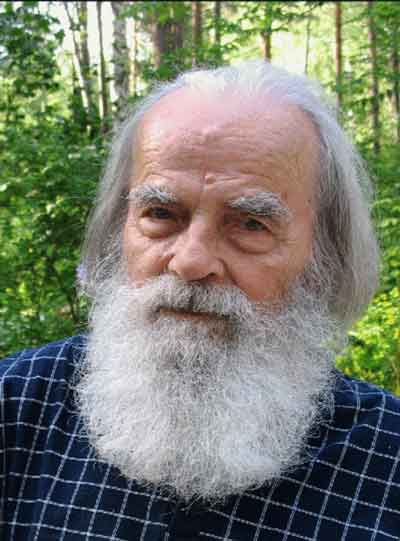- website dedicated to Boris Chirikov
- J.Bellissard, D.L.Shepelyanski, "Boris Chirikov, a pioneer in classical and quantum chaos", Annales de l'institut Henri Poincare (A) Physique theorique 68: 379 (1998) (and also here)
- Special Volume dedicated to 70th of Boris Chirikov: Physica D 131:1-4 vii (1999) and arXiv
- Article at CERN Courier (2003)
- Obituary at CERN Courier,Obituary at Physics Today (2008)
- Articles in Russian: Nauka v Sibiri (1988),Nauka v Sibiri (1998), Uspekhi Fiz. Nauk (1998),Vestnik Akademii Nauk (2005),Nauka v Sibiri (2008)
.
Boris Chirikov

Boris Chirikov, June, 2007 (Photo by Galya Chirikova)
Boris Valerianovich Chirikov (Russian Борис Валерианович Чириков) (June 6, 1928 – February 12, 2008) was an outstanding Soviet and Russian physicist. He was the founder of the physical theory of Hamiltonian chaos and made pioneering contributions to the theory of quantum chaos. In 1959, he invented the Chirikov criterion which provides an analytical estimate for the overlap of resonances (and the ensuing transition from local to global chaos) in Hamiltonian dynamical systems.
Life and physics
Boris Chirikov was born in the city Oryol, Russia, USSR. Graduated from the Moscow Institute of Physics and Technology in 1952, he worked with Budker at the Kurchatov Institute and moved with him to Siberia in September 1959 to work at the Institute founded by Budker in Akademgorodok, Novosibirsk (now Budker Institute of Nuclear Physics). He became a corresponding member of the Russian Academy of Sciences in 1983, and a full member in 1992. He worked at the Institute in Akademgorodok till his last days. He left after him wife Olga Bashina and daughter Galya Chirikova.
The name of Boris Chirikov is associated with an impressive list of fundamental results in the field of dynamical chaos and foundations of statistical mechanics. As early as 1959, in a seminal article, Chirikov proposed a criterion for the emergence of classical chaos in Hamiltonian systems, now known as the Chirikov criterion (Atom. Energ. 6: 630 (1959)). In the same paper, he applied such criterion to explain some puzzling experimental results on plasma confinement in open mirror traps, that had just been obtained at the Kurchatov Institute. This was the very first physical theory of chaos, which succeeded in explaining a concrete experiment, and which was developed long before computers made the icons of chaos familiar to everyone.
Other results obtained by his group include: analysis of the transition to strong chaos in the Fermi-Pasta-Ulam problem; the derivation of the chaos border for the Fermi acceleration model; the numerical computation of the Kolmogorov-Sinai entropy in area-preserving maps; the investigations of weak instabilities in many-dimensional Hamiltonian systems (Arnold diffusion and modulational diffusion); the demonstration that the homogeneous models of classical Yang-Mills field have positive Kolmogorov-Sinai entropy, and therefore are generally not integrable; the discovery of the power law decay of Poincaré recurrences in Hamiltonian systems with divided phase space; the demonstration that the dynamics of the Halley comet is chaotic, and is described by a simple map.
He essentially invented the Chirikov standard map, described its chaotic properties, established its ubiquity, and found a variety of applications. The quantum version of this map provides canonical kicked rotator model and demonstrates the phenomenon of dynamical localization of quantum chaos, which been observed, for example, in experiments with hydrogen and Rydberg atoms in a microwave field and cold atoms and Bose-Einstein condensates in kicked optical lattices.
The physical theory of deterministic chaos developed by Boris Chirikov has found applications in solar system dynamics, particle dynamics in accelerators and plasma magnetic traps, and numerous other systems
See also
* Chirikov standard map and standard map
* Chirikov criterion
References
* B.V.Chirikov, "Research concerning the theory of nonlinear resonance and stochasticity", Preprint N 267, Institute of Nuclear Physics, Novosibirsk (1969), (Engl. Trans., CERN Trans. 71-40 (1971))
* B.V.Chirikov, "A universal instability of many-dimensional oscillator systems", Phys. Rep. 52: 263 (1979)
* B.V.Chirikov, "Time-dependent quantum systems" in "Chaos and quantum mechanics", Les Houches Lecture Series, Vol. 52, pp.443-545, Eds. M.-J.Giannoni, A.Voros, J.Zinn-Justin, Elsevier Sci. Publ., Amsterdam (1991)
* A. J. Lichtenberg and M. A. Lieberman, Regular and Chaotic Dynamics, Second Edition, Spring-Verlag (1993).
Links
Retrieved from "http://en.wikipedia.org/"
All text is available under the terms of the GNU Free Documentation License

